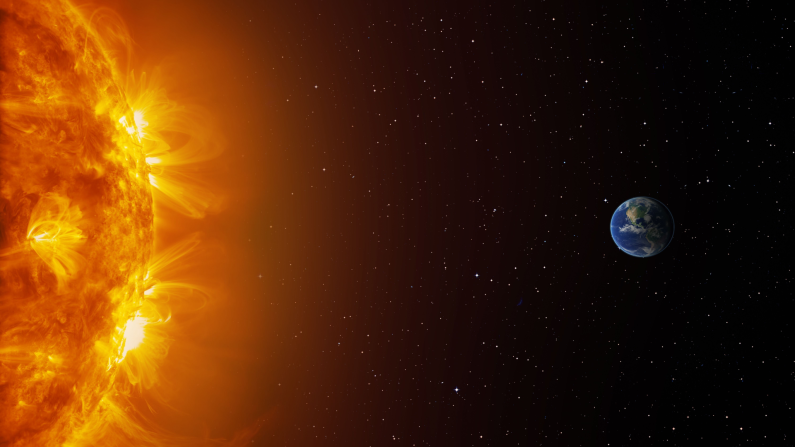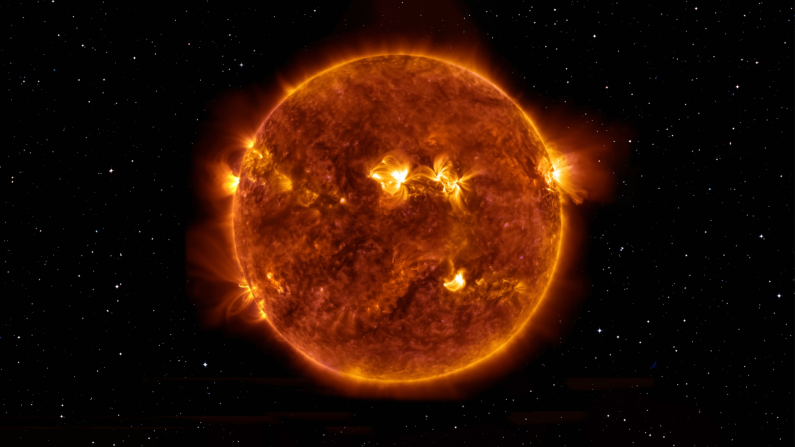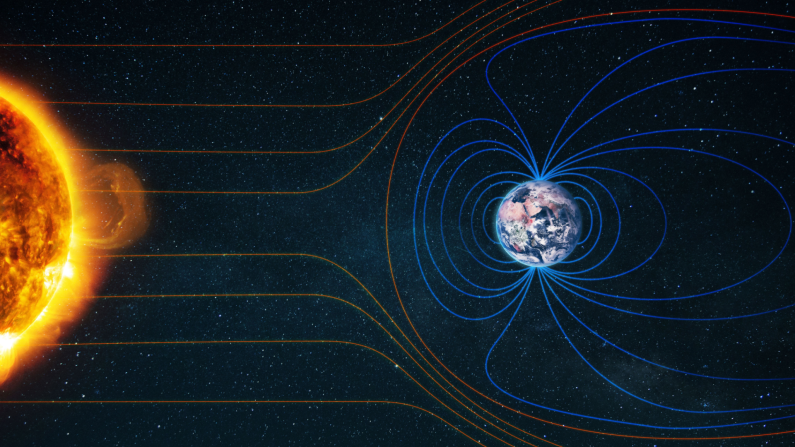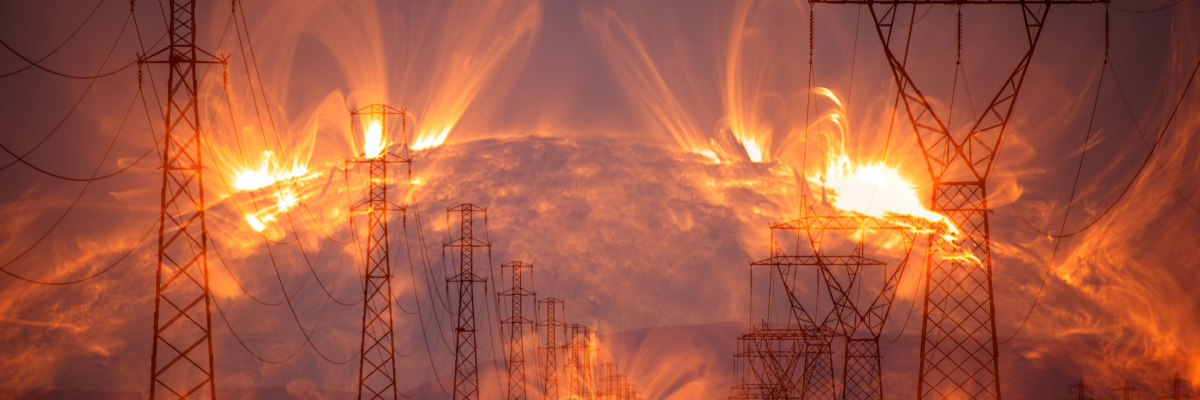In recent months, news headlines have been filled with alarming reports: “The Sun is Exploding,” “Powerful Magnetic Storm Hits Earth,” “Unprecedented Solar Activity.” Following these reports, many of us have been complaining more often about headaches, insomnia, or fatigue, attributing everything to the insidious influence of space.
But is the reason truly that the Sun has become “angrier”? And if so, why does its fury so greatly affect our lives, technologies, and even plans for space exploration? Let’s delve into the article!
What is a Solar Storm and When Was it First Discovered?

Imagine a giant, eternally pulsating ball of plasma that emits billions of tons of charged particles into space every second. That’s right, that’s exactly what our Sun looks like. Usually, it bathes Earth with what is known as the solar wind – a calm flow of these particles. But from time to time, colossal “explosions” occur on its surface – solar flares and coronal mass ejections (CMEs). It’s as if the giant Sun suddenly sneezed, sending a powerful shockwave in our direction.
When such an amplified stream of charged particles reaches Earth, it collides with our planet and its magnetic shield – the magnetosphere. A kind of “cosmic collision” occurs, which generates a magnetic storm. Earth’s magnetic field begins to “rattle” and distort, causing all the effects described above.
The connection between the Sun and terrestrial “malfunctions” was first recorded quite a long time ago, namely in 1859. This record was named the “Carrington Event.” At that time, astronomer Richard Carrington was observing the Sun and recorded a powerful flare. Almost immediately, unprecedentedly strong magnetic storms began on Earth: auroras, usually visible only in high latitudes, lit up the sky over the Caribbean and even in Mexico. But even more telling was the impact on the technologies of that time: telegraph systems around the world failed, telegraph machines gave random signals, and some even caught fire. This was the first clear evidence that solar activity directly affects our civilization.
Since then, we have known that magnetic storms can:
-
Disrupt radio communications. Shortwaves, used for long-distance communication, are particularly affected. The Earth’s ionosphere (the layer of the atmosphere that reflects radio waves) becomes unstable under the influence of solar particles.
-
Overload power grids. Powerful magnetic fields can induce electrical currents in long conductors, such as power lines. This can lead to overheating, transformer malfunctions, and even large-scale power outages, as happened in Quebec in 1989, leaving 6 million people without electricity.
-
Threaten satellites. Charged particles can damage satellite electronics, cause errors in their software, change orbits, or even disable them. This is critical for our modern infrastructure, which depends on satellites (navigation, communications, weather).
-
Reduce GPS accuracy. Navigation systems based on satellite signals also become less accurate or stop working altogether due to distortions in the atmosphere.
-
Affect human health. This topic remains the subject of scientific research and debate, but many people report feeling unwell, migraines, and blood pressure changes associated with magnetic storms. Hypotheses link this to the influence of geomagnetic disturbances on the cardiovascular and nervous systems.
Why is the Sun “Raging”? The Activity Cycle and What’s Wrong with the Sun Now

Solar activity is not a chaotic phenomenon, but a cyclical process associated with the dynamics of our star’s magnetic field. Approximately every 11 years, the Sun goes through a peak in its activity, known as the solar maximum. During this period, many more sunspots appear on its surface – regions with a strong magnetic field, from which flares and CMEs “erupt.”
We are currently approaching such a peak. The current 25th solar cycle, which began in 2019, has been more active than many experts predicted. Its maximum is expected around 2024-2026. This explains why we have seen such an increase in the number and intensity of solar storms in recent months.
Thus, November 2023 was marked by a series of powerful solar flares of class X (the most powerful), accompanied by CMEs. This led to strong geomagnetic storms of level G4 (high) on a five-point scale. Radio communications in high latitudes were affected, and GPS systems worked with interference. The beginning of 2024 also demonstrated high activity: the Sun continued to produce powerful flares, regularly causing magnetic storms of medium and high intensity. For example, in February of that year, the Earth experienced several serious geomagnetic disturbances associated with large CMEs, which again disrupted communications and navigation.
The bad news is that, according to scientists’ forecasts, the peak of solar activity in the current 25th solar cycle is most likely to occur precisely in 2025. The latest data from solar observatories confirm this. That is, we are experiencing the consequences of “solar unrest” already, right at this moment. Experts also note an increase in the number and power of solar flares, as well as more frequent coronal mass ejections directed towards Earth. This means that in 2025 we can expect even more geomagnetic storms of varying intensity, which will require increased readiness from operators of critical infrastructure and further improvement of systems for protecting against space weather. Particular attention is paid to preparing for potential extreme events, similar to the “Carrington Event,” which, although rare, are capable of causing colossal damage to modern technological civilization. Speaking of damage…
How Earth Protects Itself From Solar Flares and Storms

Surviving a solar “storm” without losses is not an easy task. But humanity is not sitting idly by. Scientists and engineers have a whole range of measures aimed at predicting, mitigating, and, as far as possible, neutralizing the consequences of solar storms.
At the forefront are early warning systems. They are like a meteorological service, only for space. Specialized satellites are working tirelessly in space, such as NASA’s Solar Dynamics Observatory (SDO) or ESA/NASA SOHO. These “space observers” continuously monitor the Sun, scanning its surface in different ranges: from X-rays to visible light. Their task is to “detect” the first signs of flares, CMEs, and other disturbances. This data is instantly transmitted to Earth, where specialists analyze it and develop forecasts.
Space weather forecasting centers, such as the NOAA Space Weather Prediction Center in the United States, like meteorologists, make forecasts using complex computer models. They predict the time, strength, and trajectory of solar “ejections.” These forecasts are sent to power grid operators, satellite management companies, and even aerospace agencies. The more accurate the forecast, the more time we have to prepare.
The next line of defense is the protection of infrastructure on Earth. Here, engineers responsible for our “electrical blood” – power grids – come into play. When a strong magnetic storm approaches, power grid operators can take preventive measures to avoid large-scale accidents. For example, they can reduce the load on transformers, the most vulnerable nodes of the power system, temporarily disconnect some power lines, or redistribute electricity between regions. Special reactive power compensation devices (STATCOM) are also used. These “smart” devices, installed at substations, help stabilize voltage, divert excess currents caused by magnetic storms, and prevent equipment overheating.
No less important is the protection of satellites and spacecraft, on which our entire modern civilization depends. Starting from the design stage, satellites are created using radiation-resistant components. The most sensitive electronic “nerves” and “brains” of satellites are shielded with special materials that absorb or reflect charged particles. In case of danger, operators can put satellites into “safe mode,” turning off less important systems and activating energy-saving protocols. Finally, to reduce financial risks, companies use space insurance. Insurance policies cover losses associated with satellite damage from solar storms, providing additional protection for the space business.
And last but not least – the protection of astronauts. Space is a dangerous environment, especially during solar flares. Therefore, before each space mission, specialists carefully analyze space weather forecasts. If a powerful storm is expected, the flight may be postponed or the trajectory changed. There are special modules with enhanced radiation protection on the International Space Station (ISS), where astronauts can take shelter during particularly strong flares. In addition, modern astronauts’ spacesuits provide a basic level of protection from solar radiation, acting as personal “space armor.”
Top Facts About Magnetic Storms for “Dessert”

And finally, some interesting facts about solar storms that will surprise you:
-
Auroras are “cosmic discharges.” When charged particles from the solar wind collide with gas molecules in the upper atmosphere of the Earth, they cause them to glow. Red and green hues are most often given by oxygen, and blue and purple by nitrogen.
-
Magnetic storms also occur on other planets that have a magnetic field, such as Jupiter or Saturn. Jupiter, for example, has such a powerful magnetic field that its “magnetic storms” can be much stronger than Earth’s.
-
Some scientists believe that animals that use the Earth’s magnetic field for navigation (for example, migratory birds, whales) may experience disorientation or stress during strong magnetic storms. Proof of this is pigeons! Scientists have found that during periods of increased solar activity, pigeons have difficulty navigating and returning home.
-
The sun “breathes” with a magnetic field. Magnetic fields on the Sun are constantly changing, twisting and reconnecting. These processes release enormous amounts of energy, which manifest as flares and CMEs.
Ultimately, understanding and preparing for solar storms is key to a safe future both on Earth and beyond. Let’s learn to live with the Sun, because it is not only a source of life, but also a formidable force of nature, requiring respect and constant vigilance.
Share this with your friends!





Be the first to comment
Please log in to comment